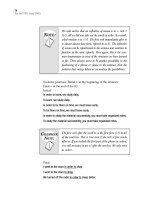4eSample poster 9
Bạn đang xem bản rút gọn của tài liệu. Xem và tải ngay bản đầy đủ của tài liệu tại đây (242.47 KB, 1 trang )
The Relationship Between Hibernation Temperature and
Immune Competence in Big Brown Bats (Eptesicus fuscus)
Roymon Jacob, John Kobilis and DeeAnn Reeder
Department of Biology
Bats have evolved a variety of physiological and behavioral
mechanisms to survive and thrive in hyper-variable environments. For
insectivorous temperate bats, like Big Brown Bats (Eptesicus fuscus),
the combined challenge of cold temperatures and lack of food is met by
autumnal fattening followed by altered thermoregulatory balance and
metabolic processes during hibernation. Despite the obvious metabolic
benefits of prolonged torpor, hibernating mammals are known to arouse
to euthermic temperatures periodically during the winter.
Many hypotheses have been put forth to explain this paradox, but
none have clearly revealed why mammals expend stored energy to
warm their bodies for relatively short periods of time. One possibility is
that these periodic arousals play a significant role in the maintenance of
immune competence, as suggested by the work of Prendergast et al.
(2002) in ground squirrels and Sulkin & Allen (1974) in both Big Brown
Bats and Little Brown Bats (Myotis lucifugus). In this study, we tested
the hypothesis that bats arouse during hibernation in order to modulate
their immune competence, and the immune functions will be altered by
the hibernation temperatures.
Methods
• Bats were housed in environmental chambers at 4°C and 8°C, and in a
flight cage ~20°C.
• In each condition, bats were assigned to one of the following
experimental groups: control, disturbance control, and immune
challenged.
• Data loggers (iBBats)
attached to each bat
recorded body
temperature every 30
Figure 1. Illustration of iBBAT data logger and example of data
min for 9 weeks (Fig. 1). obtained for one bat
• The complexity of immune responses was captured by assessing multiple
measures of immune function, such as wound healing, bacterial killing
activity, and levels of natural antibodies.
Results
10
8
6
4
2
0
35
A
4°C
8°C
Maximum arousal temperature
Total 30 min periods
spent euthermic # of arousals
• Bats housed at 8°C aroused more frequently, achieved higher body
temperatures during arousal bouts, and spent more time over the
study period at euthermic temperatures than bats housed at 4°C.
(Fig. 2 and 3)
B
25
15
5
Control bats
Immune challenged/
handled bats
Figure 2. Arousal patterns in hibernating Big Brown
Bats. (A) Number of arousals over a 9 week period. (B)
Total time spent euthermic over this period, as
measured by the number of recordings (taken at 30
min intervals) at euthermic temperatures.
40
38
36
4°C
8°C
34
32
30
28
26
24
Results continued
• Bats housed at 8°C showed greater bactericidal activity (a measurement
of constitutive innate immunity) than bats housed at 4°C, suggesting
greater immune competence in bats hibernating at the warmer
temperature (Fig. 4).
No. of E. coli colonies
after 60 min
Introduction
120
4°C
100
8°C
80
60
40
20
0
Jan
April
Figure 4. Number of E. coli colonies remaining on Tryptic Soy Agar plates after 60 min incubation
with bat plasma.
• Bats housed at euthermic temperatures were able to heal wounds in
their wing membranes (made with 3 mm biopsy punch) within 3 weeks
after creation, whereas bats housed at either hibernation temperature
showed no wound healing even after three months of wound creation
(Fig. 5).
Figure 5. Photo documentation of 3 mm biopsy wounds.
Discussion
Several studies suggest that immune responses in bats are
qualitatively and quantitatively different from those of other mammals in
that bats exhibit delayed responses to some pathogens (Calisher et al.,
2006; Reeder et al., unpublished data; Sulkin & Allen, 1974). Our
preliminary results also indicate that immune function is compromised
in hibernating bats compared to non-hibernating bats, with bats
maintained at higher hibernation temperatures exhibiting higher
compliment activity in plasma.
In light of the emergence of “White Nose Syndrome” in bats in the
North-eastern USA, in which significant number of bats are dying
during the winter, understanding how bat immune systems function is
critical. Future studies will examine immune competence in greater
detail in both Little Brown Bats and Big Brown Bats.
References
22
20
Control bats
Immune challenged bats
Figure 3. Maximum arousal temperatures (average)
exhibited by each group of bats.
Calisher, C. H., Childs, J. E., Field, H. E., Holmes, K. V., & Schountz, T. 2006. Bats: Important reservoir hosts of emerging viruses. Clin Microbiol Rev, 19,
531-545.
Prendergast, B. J., Freeman, D. A., Zuker, I. & Nelson, R. J. 2002. Periodic arousal from hibernation is necessary for initiation of immune responses in
ground squirrels. Am J Physiol Regulatory Integrative Comp Physiol 282: R1054-R1062.
Sulkin, S. E. & Allen, R. 1974. Virus infections in bats. Monographs in Virology, 8, 1-103.
Acknowledgements
Thanks for this project goes to the Pennsylvania Game Commission for providing information on field sites throughout central Pennsylvania and for the
permission to enter the hibernacula. This research was funded by Bucknell University Graduate Research Program.









